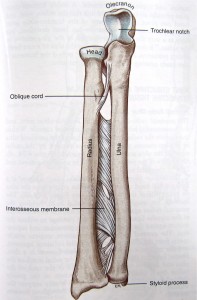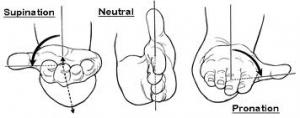 The interosseous membrane of the forearm is a thin sheet of connective tissue linking two bones, the radius and the ulna.
The interosseous membrane of the forearm is a thin sheet of connective tissue linking two bones, the radius and the ulna.
Both the shin and the forearm have two bones (tibia and fibula in the leg) that are joined through these particularly fibrous tissues.
The main functions of the interosseous membrane are to distribute weight, provide stability for the radius and ulna, and connect yet separate these bony structures.
Some forearm muscles attach to the interosseous membrane and it also separates the forearm muscles into anterior and posterior portions.
It can play an important role in preventing injury by stabilizing the radius in a number of wrist actions.
It is a particularly fibrous tissue and both its density and malleability allows greater to force to be absorbed between the two bones, so that they are less likely to break or fracture on impact.
But it is fairly easy to injure the interosseous membrane.
Ice skating, which I wrote about last week (I also got new skates for the holidays) is a classic to damage this tissue. Breaking ones fall with the heel of the palm is the easiest way to mess with the forearm in general.
When the wrist is in neutral position the interosseous membrane is stretched open and when the wrist is either supinating or pronating the interosseous membrane is in a flexed position.
In the context of the yoga practice a tight interosseous membrane is sometimes the culprit for hands that can’t stay grounded in poses like forearm stand.
While everything above the elbow is relatively easy for me in pincha mayurasana, I have always used a block between my hands because my thumbs want to slam together.
In some cases this might be a shoulder issue but in mine I think the problem lies in the forearm.
Like so many of our body parts, you can go through life without ever hearing or learning about the interosseous membrane but the more you know about this magical body that we inhabit, the better off you might be.
***

